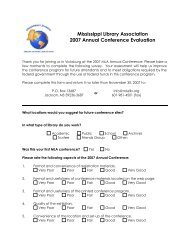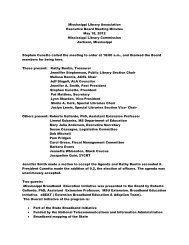Full Text (PDF) - Mississippi Library Association
Full Text (PDF) - Mississippi Library Association
Full Text (PDF) - Mississippi Library Association
- No tags were found...
You also want an ePaper? Increase the reach of your titles
YUMPU automatically turns print PDFs into web optimized ePapers that Google loves.
PAGE 46 VOL. 75, NO. 2 • SUMMER 2012 MISSISSIPPI LIBRARIESLibrarians and Architects: Q & AJoyce M. Shaw, Head, Gunter <strong>Library</strong>, andAssociate Professor • University of Southern<strong>Mississippi</strong> • joyce.shaw@usm.eduPhilip W. Shaw, Architect • Shaw DesignGroup • shawdesigngroup@cableone.netABSTRACTA librarian and an architect discussedthe process of planning and designing orrenovating a library. Their discussion is presentedin a question and answer format. Aresource list is included.INTRODUCTIONIn spite of several decades of doomsdayprophesies about the end of libraries as thephysical space we know, libraries not onlystill stand, but continue to prosper andgrow. People still use libraries. Books, magazinesand journals – in many interesting andchanging formats, continue to be published,and librarians continue to provide servicesthat help patrons navigate these changes.Libraries as a place and sense of place continueto be more than a simple repositoryfor books. In communities, schools, universities,and organizations, libraries are culturalcenters and intellectual loci.If the opportunity arises for you to beinvolved with planning a new library (orsignificantly renovating a library), then beprepared to asct as the bridge between yourinstitution and a professional design team.Whether or not your plans involve the creationof the award-winning library of thefuture, once you have made the decision toconstruct (or renovate) a library, the nextstep is to develop the relationship betweentwo professionals – the librarian and thearchitect. This article provides an overviewto building that relationship using a questionand answer format and includes a shortlist of books, articles, and Web resources tohelp you feel confident and comfortable inthe world of design and construction. Thefollowing questions posed by a librarian areanswered with the help of an architect.QUESTIONS AND ANSWERS1. Who will be involved with making theselection of the design team? Do not besurprised if you are brought into theprocess after an architectural firm hasbeen chosen.2. Is having previously designed a libraryan important factor when selecting anarchitectural firm? This is not a dealbreaker. A good architect should havethe skills to make it work.3. If the firm has not designed a library,what local commercial spaces, schools,public, or community facilities shouldbe included in its portfolio? This is thetypical scenario. Pay a visit to some oftheir other projects and note what elementsyou like and do not like.4. Has the firm worked with stakeholdersin the public arena including volunteerand elected boards, community members,college presidents, librarians, campusarchitects, and others? In somecases, the librarian will represent thesegroups and will bring the stakeholder’sissues to the table. Having a designerwho is willing to meet with the stakeholdersis a plus.5. What specifics do architects need toknow about your library? This is themost important question! Try to detailthis part of the discussion as comprehensivelyas possible to the team. If you areusing this renovation or new building tomake major changes in your services,programs, the collection, or technology,now is the time to describe how you seethe space functioning now and in thefuture.6. If you are involved with fundraising or acapitol campaign for funding the constructionor renovation, have you partneredwith the design firm for help withcreating supporting materials? The firmcan provide renderings, descriptions,models, and other props which will helpexplain the project to potential donors.7. How important is having a “green” (sustainable)project? Does the firm haveexperience with LEED requirements andstandards? Architects are very good atmaking green choices that are also longterm money savers. If having a LEEDcertified project is a selling point todonors or important for grants, be sureto make that known to the design team.8. When is the best time to discuss finisheson counter tops, types of windowshades, and carpet color? Interior decoratingis best discussed near the end ofthe process. Most firms have someonewho will work with you on finishingdetails.The best way to approach a constructionor renovation project is to be familiar withthe concepts and vocabulary. Coming intothe process as the library expert withenough information to feel comfortablewith the process will make you a valuableresource for the design team. Use the followingresource list to get a start on theprocess. RESOURCE LISTAmerican Institute of Architects. You and YourArchitect: A Guide for a Successful Partnership.http://info.aia.org/blast_images/mrkt/brochure_wtw_yaya.pdf (accessed April 29,2010).Darnton, Robert. “5 myths about the ‘InformationAge.’” The Chronicle of Higher Education,April 17, 2011. http://chronicle.com/article/5-Myths-About-the-Information/127105/ (accessed April 20, 2011).Rolf Erikson and Carolyn Markuson, Designinga School <strong>Library</strong> Media Center for the Future.Chicago: American <strong>Library</strong> <strong>Association</strong>,2007.Latimer, Karen. “Redefining the library: currenttrends in library design.” Art LibrariesJournal 35 (2010): 28-35.Leighton, Philip D., and David C. Weber.Planning Academic and Research <strong>Library</strong>Buildings. Chicago: ALA, 1999.Murdock, James. “Beauty and the book,” ArchitecturalRecord. http://archrecord.construction.com/projects/building_types_study/libraries/2011/libraries-intro.asp (accessedMay 5, 2011).Sannwald, William W., ed. Checklist of <strong>Library</strong>Building Design Considerations. Chicago:ALA, 2001.Steward, Christopher. The Academic <strong>Library</strong>Building in the Digital Age: A Study of Construction,Planning, and Design of New<strong>Library</strong> Space. Chicago: ACRL, 2010.U.S. Green Building Council. http://www.usgbc.org/ (accessed May 5, 2011).Woodward, Jeannette A. Countdown to a New<strong>Library</strong>: Managing the Building Project.Chicago: ALA, 2000.














